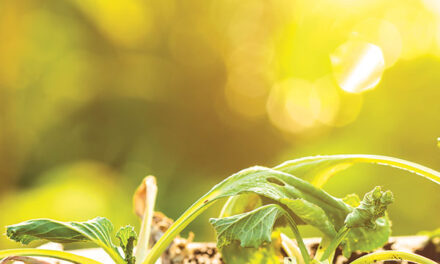Inglorious garden goofs, accompanied by groans or expletives, are painfully inevitable. To goof is human, but navigating the minefield of mayhem is less painful when you know where to step.
Severing a drip irrigation line is a common garden goof. Polyethylene tubing is often buried by bark mulch, foliage or soil. Once pierced by a shovel head, hoe or hand pruners, the line must be repaired with spare parts or worse—an annoying trip to the garden center for necessary parts. Either way, it is a disruption.
Always expose drip irrigation lines before working in an area. Pull the landscape staples that secure the lines and move the tubing away before digging or weeding.

In the film “Road House,” bouncer Patrick Swayze explains to his security staff, “I want you to be nice until it’s time to not be nice.” Same goes for growing mint. Mint, fragrant and a wonderful culinary herb, is an escape artist that can be an invasive nightmare for years.
An epic garden goof is planting mint in an open area of the garden. It will take over large spaces and choke out other plants. Removing it can be a monumental task, if not impossible. Plant mint in containers raised off the ground. Even in a container, keep an eye on its wandering habit or it will be time to not be nice.
Invasive plants to avoid include Mexican feathergrass, pampasgrass and English ivy. The California Invasive Plant Council website has a list of bad guys.
Allowing fruit and citrus trees to grow unchecked is a stealth garden goof. You let peach and pluot trees stretch skyward with good intentions, but the result may be regrettable.
At the Fair Oaks Horticulture Center, most of the fruit and citrus trees are pruned to maintain a height of no more than 7 feet. These trees are called fruit bushes.
Smaller trees allow for additional fruit trees in an urban backyard. More trees of varying varieties can extend the season and ladders are rarely needed to harvest the delicious orbs. Reach up and pluck away. Another perk is less mess and debris from unreachable fruit sampled and discarded by squirrels, rats and birds.
To visit a fruit bush orchard and learn about pruning and maintenance, there will be two upcoming Open Gardens—May 20 and June 17, 9 a.m. to noon—at the Fair Oaks Horticulture Center. Admission is free.
Home gardeners purchase heavy sacks of potting soil, soil amendments and bark mulch. A wise investment is a wheelbarrow or garden cart to transport the sacks. Younger and stronger gardeners may sling a sack over the shoulder, but the body eventually will signal a painful goof.
Ask the garden center to load the sacks. Once home, slide the sacks into the wheelbarrow or cart and dump where needed. Open sacks with a box cutter or pocketknife and spread the contents. No unnecessary lifting and no trip to urgent care.
Gardeners can spend considerable time and effort weeding. Ignoring weeds for a week or two is a colossal mistake. Sacramento is rife with awful weeds like spotted spurge, which can form thousands of seeds per plant if left unchecked. Bare soil is best friends with spotted spurge, so spread a thick layer of bark mulch or wood chips to discourage the thug.
Nutsedge (often called nutgrass) forms numerous nutlets below ground if allowed to mature. Each nutlet becomes a new weed. Dig nutsedge out before it matures, nutlets and all, and eventually you can control this nuisance weed.
Photos and information on Sacramento’s most common weeds can be found on the Master Gardeners of Sacramento County website at sacmg.ucanr.edu. Go to “Weeds” on the left side.
Set aside 10 to 15 minutes a couple of times a week for weeding. Be as persistent as the weeds. No goofing off.
Dan Vierria is a University of California Cooperative Extension Master Gardener for Sacramento County. He can be reached at masterg29@gmail.com. For answers to gardening questions, contact the UCCE Master Gardeners at (916) 876-5338, email mgsacramento@ucanr.edu or visit sacmg.ucanr.edu. Follow us on Facebook, Twitter and Instagram: @insidesacramento.
















